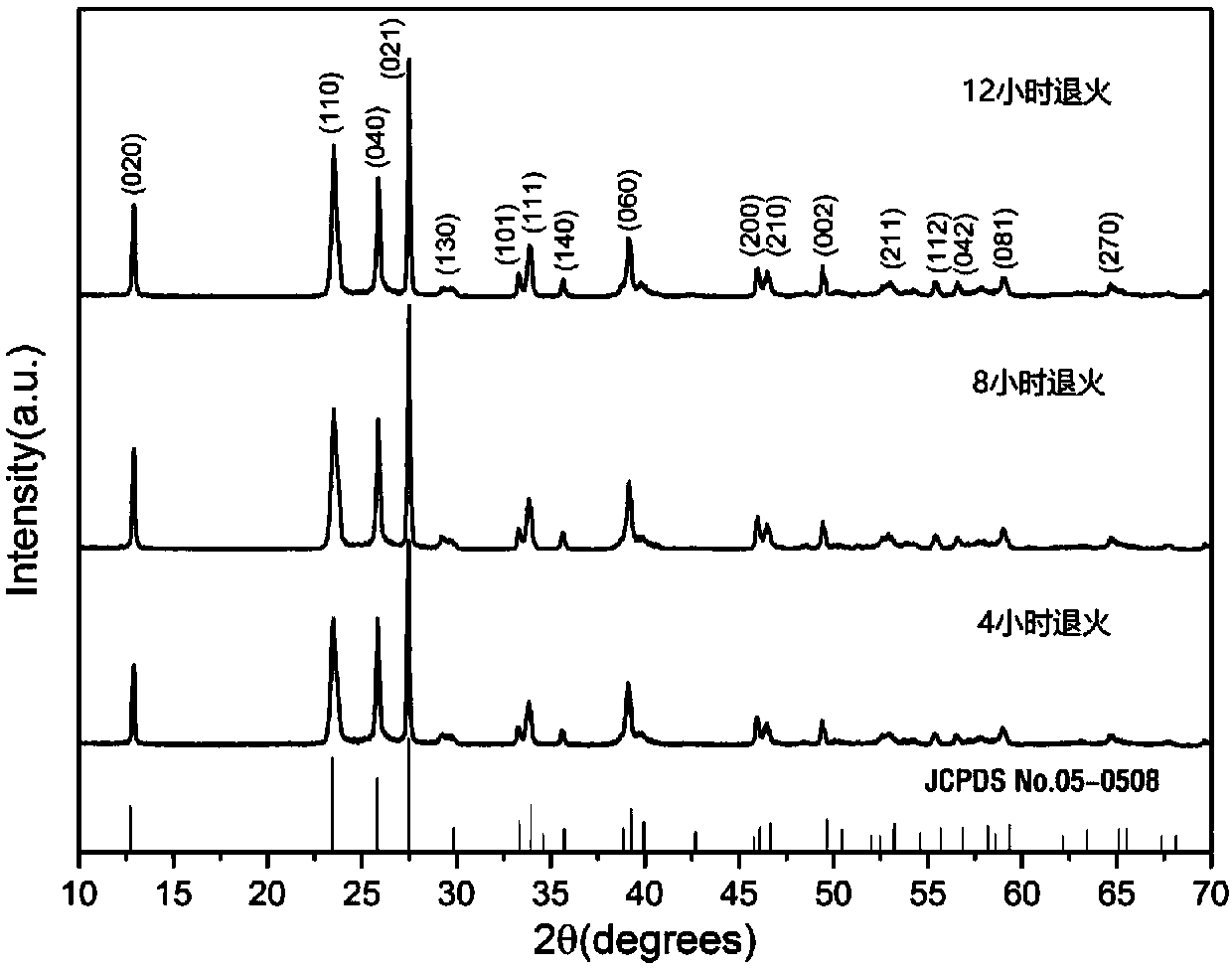A kind of preparation method of high-performance supercapacitor electrode
A supercapacitor, high-performance technology for hybrid capacitor electrodes, hybrid/electric double-layer capacitor manufacturing, nanotechnology for materials and surface science, etc. Effect
- Summary
- Abstract
- Description
- Claims
- Application Information
AI Technical Summary
Problems solved by technology
Method used
Image
Examples
Embodiment 1
[0025] Example 1, α-MoO annealed for 4 hours 3 Preparation of Electrode Sheets
[0026] This example prepares α-MoO according to the following steps 3 Electrode sheet:
[0027] (1) h-MoO 3 Preparation of Nanomaterials
[0028] Will 0.005M (NH 4 ) 6 Mo 7 o 24 4H 2 O solution with 2M HNO 3 The solution was mixed evenly at a volume ratio of 8:1, and then placed in a constant temperature water bath at 85°C for 60 minutes; the resulting product was ultrasonically treated, filtered, and dried to obtain h-MoO 3 nanomaterials;
[0029] (2)α-MoO 3 Preparation of Nanolaminated Materials
[0030] h-MoO obtained in step (1) 3 Nanomaterials are placed in a muffle furnace, annealed at 500°C (the time required to rise from room temperature to 500°C is set to 100 minutes) for 4 hours, and then naturally cooled to room temperature to obtain α-MoO 3Nano laminated materials;
[0031] (3) Preparation of supercapacitor electrodes
[0032] The α-MoO obtained in step (2) 3 The nano-...
Embodiment 2
[0038] Example 2, α-MoO annealed for 4 hours 3 Preparation of Electrode Sheets
[0039] This example prepares α-MoO according to the following steps 3 Electrode sheet:
[0040] (1) h-MoO 3 Preparation of Nanomaterials
[0041] Will 0.005M (NH 4 ) 6 Mo 7 o 24 4H 2 O solution with 2M HNO 3 The solution was mixed evenly at a volume ratio of 8:1, and then placed in a constant temperature water bath at 85°C for 60 minutes; the resulting product was ultrasonically treated, filtered, and dried to obtain h-MoO 3 nanomaterials;
[0042] (2)α-MoO 3 Preparation of Nanolaminated Materials
[0043] h-MoO obtained in step (1) 3 Nanomaterials are placed in a muffle furnace, annealed at 500°C (the time required to rise from room temperature to 500°C is set to 100 minutes) for 8 hours, and then naturally cooled to room temperature to obtain α-MoO 3 Nano laminated materials;
[0044] (3) Preparation of supercapacitor electrodes
[0045] The α-MoO obtained in step (2) 3 The nano...
Embodiment 3
[0050] Example 3, α-MoO annealed for 12 hours 3 electrode sheet preparation
[0051] This example prepares α-MoO according to the following steps 3 Electrode sheet:
[0052] (1) h-MoO 3 Preparation of Nanomaterials
[0053] Will 0.005M (NH 4 ) 6 Mo 7 o 24 4H 2 O solution with 2M HNO 3 The solution was mixed evenly at a volume ratio of 8:1, and then placed in a constant temperature water bath at 85°C for 60 minutes; the resulting product was ultrasonically treated, filtered, and dried to obtain h-MoO 3 nanomaterials;
[0054] (2)α-MoO 3 Preparation of Nanolaminated Materials
[0055] With step (1) gained h-MoO 3 Nanomaterials are placed in a muffle furnace, annealed at 500°C (the time required to rise from room temperature to 500°C is set to 100 minutes) for 12 hours, and then naturally cooled to room temperature to obtain α-MoO 3 Nano laminated materials;
[0056] (3) Preparation of supercapacitor electrodes
[0057] The α-MoO obtained in step (2) 3 The nano-l...
PUM
 Login to View More
Login to View More Abstract
Description
Claims
Application Information
 Login to View More
Login to View More - R&D
- Intellectual Property
- Life Sciences
- Materials
- Tech Scout
- Unparalleled Data Quality
- Higher Quality Content
- 60% Fewer Hallucinations
Browse by: Latest US Patents, China's latest patents, Technical Efficacy Thesaurus, Application Domain, Technology Topic, Popular Technical Reports.
© 2025 PatSnap. All rights reserved.Legal|Privacy policy|Modern Slavery Act Transparency Statement|Sitemap|About US| Contact US: help@patsnap.com



